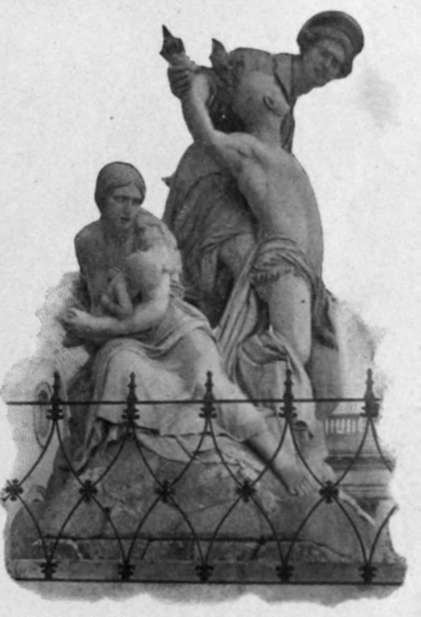Groups And Statues On The Central Portico
Description
This section is from the book "The National Capitol. Its Architecture Art And History", by George C. Hazelton, Jr. Also available from Amazon: The National Capitol Its Architecture Art and History.
Groups And Statues On The Central Portico
The two marble groups upon the blockings over the porte-cochere of the central building attract considerable attention because of their prominence. The one to the north is by Greenough, and is popularly called "The Rescue." It was designed in 1837 and completed in 1851. The story is that of a frontiersman saving his wife and child from massacre at the hands of an Indian brave. On the corresponding blocking to the south is a group by Persico (1844), known as "The Discovery.'* The central figure is that of Columbus, triumphantly holding aloft in his hand a ball representing the globe. By his side cowers an Indian girl, awed at the sight of the white man. It is said that the artist copied the armor from that still preserved in Genoa, Italy—one of the many authentic suits which Columbus wore when he discovered America.
These groups were the outcome of a joint resolution of March 4, 1837, by which the President was authorized to contract for two groups of statuary to be placed upon these blockings. Eight thousand dollars were appropriated for the work; but, as usual, the final cost far exceeded the intention, the expense to the government being nearly $56,000 in all. Persico received the first order. The contract for the second group was made with Greenough while he was at work in Florence upon his statue of Washington, and while wonderful reports of its excellence were being brought to America by his friends. It also was urged on his behalf that a native sculptor should have a commission for one of the groups in order that American and foreign art might be well contrasted at the Capitol. It is fortunate that no country need rely on either production to establish its artistic excellence.
The two marble figures in the niches at the back of this portico, to the right and left of Rogers' bronze doors, command critical admiration for grace and dignity of pose, strength in modeling, and appropriateness of design. These statues are of Mars and Ceres, the man in Roman mail with shield and sword—emblems of war; and the woman bearing the fruitful olive branch —personification of peace. They were authorized by the appropriation bill of March 3, 1829, which contained a clause " to enable the President to contract with Luigi Persico to execute two statues for the east front of the Capitol." The conclusion of this contract with the Italian sculptor was the last official act of John Quincy Adams as President of the United States.

THE RESCUE Greenough.
Each statue cost the government $12,000. They must have been placed in their present positions since 1835, as not till then was an appropriation made by Congress for the niches in which they stand.
On the wall of the central portico above the bronze doors is a work by Capellano (1827). It represents the head and shoulders of Washington, with two angelic figures in the act of crowning his brow with triumphal wreaths.
Continue to:
